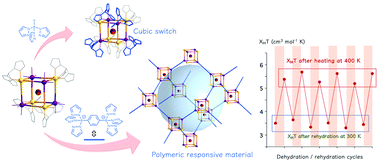Building responsive materials by assembling {Fe4Co4} switchable molecular cubes†
Abstract
Responsive materials that can answer to chemical or physical external stimuli offer numerous prospects in material science. Here, we have elaborated a two-step synthetic approach that allows incorporating molecular cubic switches into a polymeric material. Firstly, a preformed half-capped, Cs+-templated {Fe4Co4} cyanido-polymetallic cubic unit (“pro-cube”) is obtained and proven to be stable in solution, as demonstrated by paramagnetic NMR. Secondly, the reaction of the pro-cube with a ditopic scorpionate ligand enables the precipitation of a polymeric network containing the cubic unit. Furthermore, the adequately chosen ditopic ligand that coordinates the Co ions of the pro-cube allows us to preserve the switchable properties of the cubic unit. Indeed, the magnetic properties of the polymeric material compare well with those of the molecular cubic model that is obtained by reacting a non-bridging scorpionate ligand, and that was prepared as a reference. Both the polymeric material and the molecular model cube show a thermally-induced metal–metal electron transfer near room temperature. Interestingly, the magnetic state of the polymeric material is shown to depend on its hydration state, indicating its capability to act as a chemo-sensor.



 Please wait while we load your content...
Please wait while we load your content...